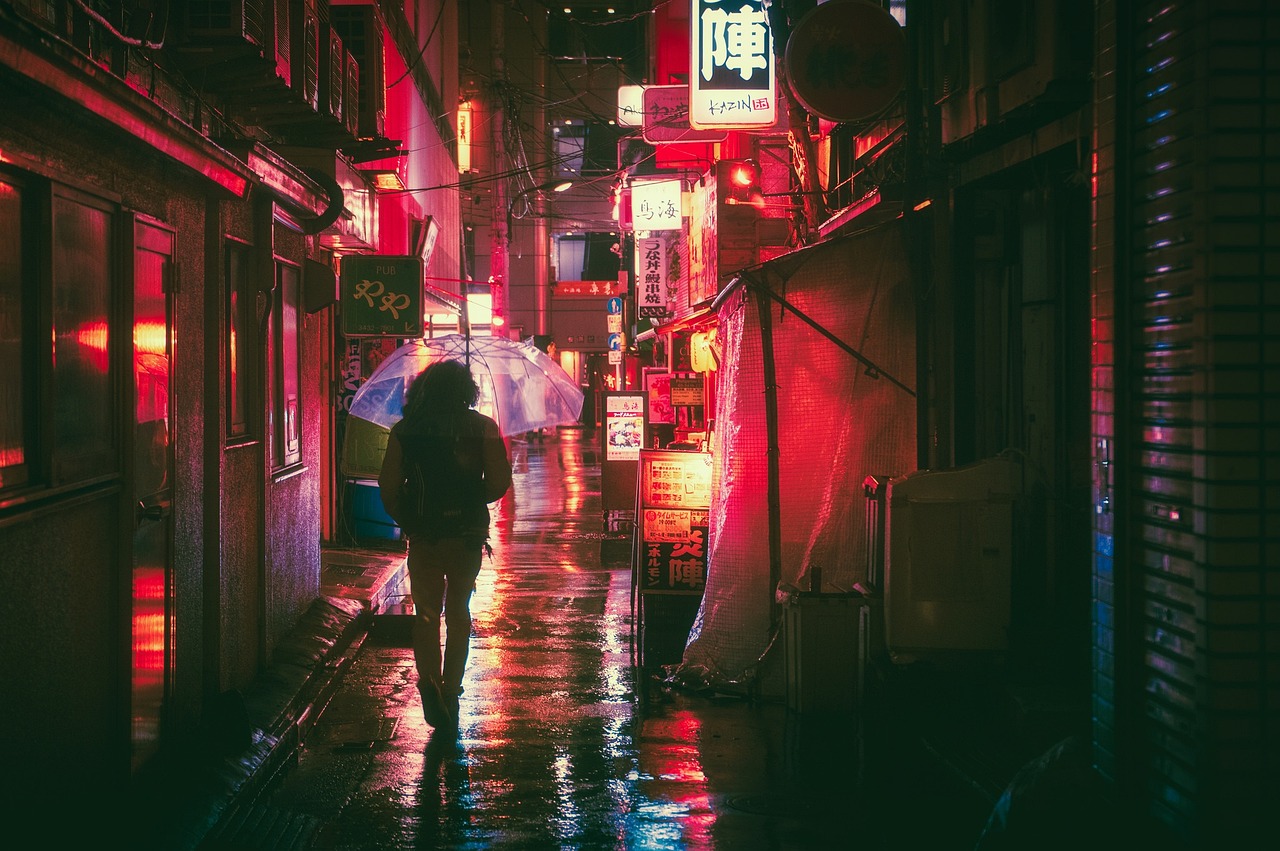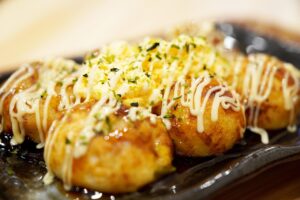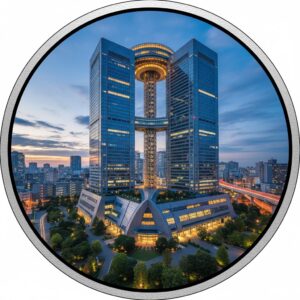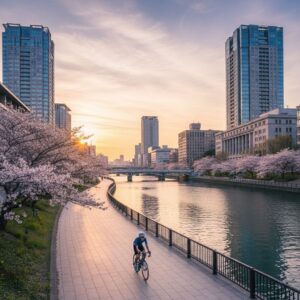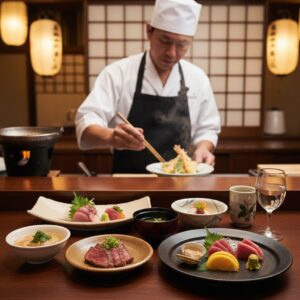Step off the train at Tenma Station, and you don’t arrive at a destination; you fall into a different current of time. The air, thick with the savory smoke of grilled meats and the faint, sweet scent of sake, tells you a story before you’ve even taken a dozen steps. This isn’t the neon-blasted, futuristic Osaka of popular imagination. This is Tenma, a sprawling, beautifully chaotic neighborhood that exists as the city’s living, breathing soul. It’s a place where the salaryman sheds his suit jacket, the shopkeeper wipes down the counter after a long day, and the night begins not with a grand announcement, but with the simple, satisfying clink of glasses. To come here is to seek more than just a meal or a drink; it’s to participate in a ritual as old as the city itself—the art of hashigo-zake, or bar-hopping. This is where Osaka lets its hair down, where conversations flow as freely as the beer, and where every lantern-lit doorway promises a new discovery. This isn’t just a place to visit; it’s a rhythm to fall into, a sprawling, delicious puzzle waiting to be explored, one small plate and one perfectly poured drink at a time. Welcome to the heart of authentic Osaka nightlife.
After immersing yourself in the lantern-lit alleys of Tenma, consider ascending to the breathtaking Floating Garden Observatory for a panoramic perspective of the city you’ve just explored from its vibrant heart.
The Pulse of a City After Dark

To truly grasp Tenma, you must first tune into its soundscape. It’s a symphony of charming discord. The constant, percussive rattle of the JR Loop Line overhead sets the beat. Beneath it, you catch the sizzle of oil hitting a hot grill, the steady chop of a knife on a well-worn cutting board, and the boisterous laughter bursting from behind a sliding door. Voices here aren’t muted; they are vibrant, full-throated celebrations of a day’s end and a night’s beginning. This isn’t the polished, curated vibe of a downtown entertainment district. Tenma is gloriously and unapologetically raw. Its narrow alleys, or yokocho, form a tight web of human connection, where you can sometimes overhear snippets of three different conversations at once. The warm glow of red paper lanterns, or akachochin, bathes the pavement in inviting light, each one a beacon marking an oasis of food, drink, and camaraderie. The atmosphere is electric yet intimate. You may find yourself shoulder-to-shoulder with strangers at a standing bar, yet within minutes, a shared appreciation for a plate of perfectly grilled chicken skin or a crisp, cold highball can create a temporary, beautiful bond. This is the heart of Tenma’s magic: it breaks down barriers, welcoming everyone into its noisy, joyful, and utterly delicious chaos.
A Tapestry Woven from History and Faith
Tenma’s reputation as a center of gastronomy and celebration is far from a recent development. Its origins are deeply embedded in the rich history of Osaka, intertwined with faith, commerce, and community life. The neighborhood’s identity is significantly influenced by its proximity to the venerable Osaka Tenmangu Shrine, a spiritual cornerstone of the city for over a millennium. This shrine is more than just a historical site; it is a living presence that has shaped the district’s character for centuries.
The Shrine’s Lasting Influence
Established in the 10th century, Osaka Tenmangu is dedicated to Sugawara no Michizane, the god of scholarship and learning. For hundreds of years, it has served as a focal point for worship and pilgrimage. Significant institutions often foster vibrant communities around them, and Tenmangu is no different. The streets near the shrine historically catered to the needs of worshippers and visitors, providing rest, nourishment, and supplies. This tradition of hospitality laid the foundation for Tenma’s contemporary food and drink culture. The welcoming spirit toward travelers, offering a place of comfort, remains evident in the friendly greetings from the taisho, or masters, of local izakayas. Additionally, the shrine hosts the spectacular Tenjin Matsuri, one of Japan’s three major festivals. This grand summer event, with its river processions and dazzling fireworks, fills the neighborhood with vibrant energy, reinforcing Tenma’s role as a hub of communal celebration. The festival’s joyous, uninhibited spirit lingers in Tenma’s streets all year long.
The Market’s Rich Legacy
Alongside its spiritual significance, Tenma thrived as a commercial hub. It was historically situated next to one of Osaka’s main wholesale markets—a bustling center where fresh produce and seafood from across Japan arrived daily. This ready access to the freshest ingredients sparked the culinary boom that characterizes Tenma today. The small eateries and bars that emerged did not rely on elaborate menus or complex techniques; their greatest strength was the exceptional quality of their raw ingredients. A piece of sashimi carried the essence of the sea it was caught from that very morning. Grilled vegetables burst with sun-soaked flavor. This tradition of freshness and quality continues today. Although the old market has relocated, its spirit endures. Tenma’s chefs and cooks are experts in simplicity, knowing that the best way to honor a perfect ingredient is to let it shine. This deep connection to the market explains the remarkable value and quality available here. The food isn’t just delicious; it represents an honest expression of Osaka’s longstanding title as Tenka no Daidokoro, the Nation’s Kitchen.
Mastering the Art of Hashigo-zake

The authentic way to experience Tenma is not by remaining in one spot all evening, but by embracing the fluid, nomadic pleasure of hashigo-zake. The phrase literally means “ladder drinking,” evoking the image of moving from one bar to another, sampling the unique offerings each has. It’s a progressive dinner combined with a social adventure. The aim isn’t intoxication but exploration—a journey through flavors, atmospheres, and fleeting, delightful human connections. Each venue marks a new chapter in the night’s story.
The Unwritten Rules of the Road
Although Tenma is very welcoming, understanding a bit of local etiquette will make your visit smoother and more enjoyable. Treat each stop as a brief, focused encounter. The custom is to order just one or two small dishes and a drink. Stay long enough to savor them, soak up the ambiance, then politely move on. This keeps the energy alive and, practically speaking, frees up limited seating for the next group of visitors. Most places are small, some accommodating fewer than ten people. Be considerate of your space and keep your belongings compact. When it’s time to leave, a simple nod to the staff and the phrase “Okanjo, onegaishimasu” (The bill, please) is sufficient. In many smaller, more traditional spots, you pay right at your seat. Tipping isn’t customary in Japan, but saying “Gochisousama deshita” (Thank you for the meal) as you leave is always warmly appreciated.
Decoding the Lanterns: A Field Guide to Tenma’s Establishments
Tenma’s maze of bars includes a dazzling array of places, each with its own character. Learning to identify them is part of the fun.
Tachinomi: The Standing Bars
Tachinomi, or standing bars, are the classic introduction to Tenma drinking. These no-chair spots emphasize efficiency and sociability. People stand along a basic counter, creating an open, communal atmosphere where chatting with neighbors is encouraged if not expected. Menus tend to be simple, focused on quick, tasty bites that pair perfectly with beer or sake. They’re ideal for your first or second stop, offering a quick, affordable, and genuinely local experience.
The Classic Izakaya
Often translated as “pub,” the Japanese izakaya offers much more than that. It’s a home away from home, where unpretentious food and relaxed conversation thrive. In Tenma, you’ll find countless izakayas, from long-established family-run joints to newer spots. Here, you can sit down and explore an extensive menu. Expect a wide range of Japanese comfort foods: succulent yakitori skewers, delicate sashimi plates, rich doteyaki (slow-cooked beef sinew), and warm bowls of oden. The pace here is more leisurely than at a tachinomi, making it a perfect place to settle in for a longer stay.
Specialty Shops: Masters of a Single Craft
Some of Tenma’s greatest delights come from establishments devoted to perfecting a single craft. You might find a tiny bar serving exclusively premium sake from one region, with a knowledgeable host guiding you through each bottle’s nuances. Or a yakitori-ya where the chef has honed the art of grilling every part of a chicken over charcoal. There are bars known for fresh oysters, shops famed for tempura, and places whose reputation rests on one flawless dish. Seeking out these specialists rewards you with deep insight into the dedication behind Japanese culinary artistry.
The Tenma Menu: What to Drink and Eat
The abundance of choices may seem daunting, but a few staples make a perfect introduction to Tenma’s flavors.
The Libations
Your first order at any izakaya should almost always be “Toriaezu, nama,” meaning “For now, a draft beer.” It’s the classic starting signal for a night in Japan. From there, the options open up. The highball—Japanese whisky with sparkling water served ice-cold—is everywhere: refreshing and dangerously drinkable. For more variety, try a chu-hai, a shochu-based highball available in many fruit flavors like lemon, grapefruit, and yuzu. And, of course, there’s sake. Don’t be intimidated—many places offer a house sake (atsukan for warm, hiya for cold) that’s always a solid choice. Feeling adventurous? Point to an intriguing name on the menu and see what arrives. Staff are nearly always eager to help you pick something you’ll enjoy.
The Edibles
Food in Tenma is designed for sharing and snacking. Begin with simple items like edamame or Japanese-style potato salad. For a true taste of Osaka, try doteyaki, a rich miso stew with tender beef sinew that melts in your mouth. Kushikatsu, deep-fried skewers of meat, seafood, and vegetables, is another local specialty (remember the golden rule: no double-dipping in the communal sauce!). Seafood is always a stellar choice in Tenma—look for spots advertising fresh sashimi or grilled fish. And never skip a good yakitori joint. From classics like chicken thigh (momo) and spring onion (negima) to more adventurous cuts like heart (hatsu) and cartilage (nankotsu), each skewer delivers a small, smoky bite of perfection.
Your Blueprint for a Night in Tenma
While Tenma’s greatest delight is aimless wandering, having a general geographical starting point can be useful for first-time visitors. The neighborhood is a dense web of streets and alleys, each offering its own distinct microcosm of sights and sounds.
The Tenjinbashisuji Artery
Spanning an impressive 2.6 kilometers, the Tenjinbashisuji Shopping Street holds the title of Japan’s longest covered shopping arcade. Though the main street itself is a captivating spot for shopping and casual dining during the day, the true enchantment for bar-hoppers lies in the countless narrow alleys and side streets branching off from this main artery. Think of the grand arcade as your spine, with smaller veins drawing you inward. It’s within these tight passages, away from the brighter lights of the main street, that many of Tenma’s most beloved and atmospheric bars and eateries await.
Under the Tracks: The Viaduct Kingdom
The area surrounding and beneath the elevated tracks of JR Tenma Station stands as perhaps the district’s most iconic and densely packed section. Here, a lively ecosystem of restaurants and bars has flourished in the spaces beneath the railway viaduct. The steady rumble of trains overhead blends into the ambient soundtrack. This area offers sensory overload in the best sense: a riot of colorful signs, enticing aromas, and the continual hum of cheerful crowds. Classic tachinomi and smoky yakitori shops abound here, making it a perfect starting point for your hashigo-zake journey. The incredible concentration of venues means you can easily hop from one unique spot to another within just a few steps.
Practical Wisdom for the Intrepid Explorer

A bit of preparation can significantly enhance your Tenma experience, making it as smooth and enjoyable as possible.
Arrival and Departure
Tenma boasts excellent connectivity. The easiest route is via the JR Osaka Loop Line to Tenma Station. Alternatively, you can take the Sakaisuji subway line to Ogimachi Station, which is only a brief walk away. Since your evening will likely involve drinking, relying on the reliable public transportation system is the smartest choice. Be sure to check the last train times, usually around midnight but varying by line. If you stay out later, taxis are readily available.
The Rhythm of the Night
Tenma begins to come alive around 5:00 PM as local workers call it a day. Arriving between 5:30 PM and 7:00 PM is ideal, giving you a chance to secure a spot before the busiest time. Weekdays tend to draw a more local, after-work crowd, while Friday and Saturday nights buzz with higher energy and larger groups. Both offer fantastic, yet somewhat different, experiences. Bear in mind that many small, family-run places may be closed on Sundays or another day of the week, so staying flexible is advisable.
The Currency of Connection
Although Japan is becoming more credit card-friendly, many traditional establishments that define Tenma’s charm often accept only cash. It’s important to bring enough Japanese Yen to cover your evening’s activities. This way, you avoid the hassle of hunting for an ATM and can easily enjoy any hidden gems you stumble upon. Carrying smaller bills and coins will also speed up transactions at each stop.
Bridging the Language Gap
Don’t let limited Japanese discourage you. The language of great food and drink is universal, and Tenma’s warm hospitality goes beyond words. Many places offer picture menus, or you can simply point to appealing dishes at a neighbor’s table. A few basic phrases go a long way: Sumimasen (Excuse me, to get attention), Kore, kudasai (This one, please), Arigatou gozaimasu (Thank you very much), and Oishii! (Delicious!). A smile and a willingness to engage are your best tools. Locals and staff are generally friendly and patient, appreciating your effort to connect with their culture.
A Final Toast to Tenma’s Enduring Spirit
An evening in Tenma is more than just a simple pub crawl—it is a deep immersion into the essence of Osakan life. It celebrates the unpretentious, the communal, and the immensely satisfying. Here, amid these winding alleyways, beneath the rumble of the train and the soft glow of paper lanterns, you encounter the city’s true spirit. It’s found in the bartender’s gesture as they slide a perfectly chilled glass across the counter, in the shared laughter between strangers over a plate of grilled squid, and in the quiet delight of discovering a flavor you never knew existed. Tenma reminds us that the most memorable travel experiences are not always in grand monuments but in the small, fleeting moments of human connection. It invites you to get a little lost, be a little adventurous, and open yourself to the simple, profound joy of sharing a drink and a story. So arrive with an empty stomach and a curious heart. The lanterns are glowing, the grills are hot, and the warm, welcoming spirit of Osaka awaits you. Kanpai!
